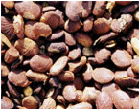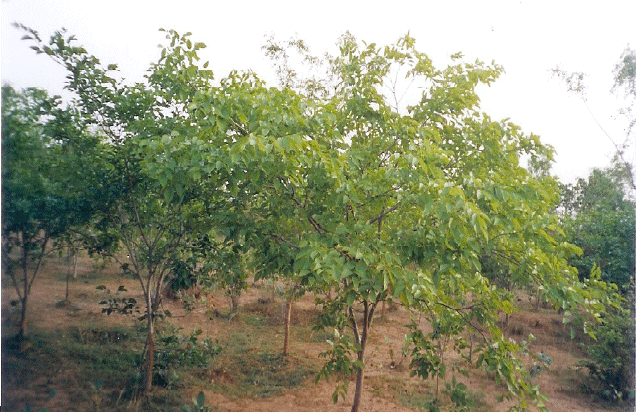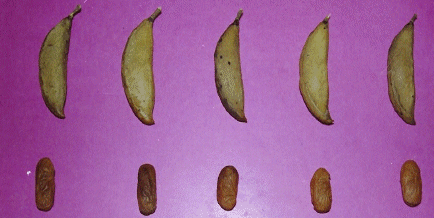
Pongamia Pinnata
Mission
Feasibility Study
Plant
Drip Irrigation
Soil Test
Pre-Plantation
Plantation
Post-Plantation
Large Plantation
NGO Model
C D M
Insurance
Neem
Mahua
Castor
Undi
Kokam
Fish Oil
BioFuels
Fatty Oils
Expellers
BioGas
Organic Fertilizer
Jatropha
BioDiesel
Consultancy
Algae
Herbal Product
Climate Adaptation
Contact Me
My Resume
 |
Satish Lele lelejatropha@gmail.com |

Karanj (Pongamia Pinnata)

Pongamia Pinnata trees are normally planted along the highways, roads and canals to stop soil erosion. Billions of trees exist all over India. If the seeds fallen along road side are collected, and oil is extracted at village level expellers, thousands of tons of oil will be available for Lighting the Lamps in rural area. Karanj oil is the best oil for lighting. Since these are spread over a large area, collection of seeds for BioDiesel manufacture is not viable. (A compact plantation can support a BioDiesel plant). Pongamia Pinnata is called as Koroch in Bangladesh. There, Karanj is a fresh water flooded plant / tree. The seedlings of Koroch can survive in 1.5 meters deep water submergence / inundation for five to six months duration at a stretch. There are nearly 30,000 square km of water reservoirs in India. This tree can be cultivated in such water storage reservoirs up to 1.5 meters depth and reap additional economic value from unused reservoir lands.

Pongamia Pinnata is one of the few nitrogen fixing trees to produce seeds containing 30 to 32% oil. Karanj is often planted as an ornamental and shade tree. This specie is commonly called Pongam, Karanj, or a derivation of these names.
Botany: Pongamia (Leguminoceae, subfamily Papilionoideae) is a medium sized tree that generally attains a height of about 8 meters and a trunk diameter of more than 50 cm. The trunk is generally short with thick branches spreading into a dense hemispherical crown of dark green leaves. The bark is thin gray to grayish-brown, and yellow on the inside. The tap root is thick and long, lateral roots are numerous and well developed.
The alternate, compound pinnate leaves consist of 5 or 7 leaflets which are arranged in 2 or 3 pairs, and a single terminal leaflet. Leaflets are 5 to 10 cm long, 4 to 6 cm wide, and pointed at the tip. Flowers, borne on racemes, are pink, light purple, or white. Pods are elliptical, 3 to 6 cm long and 2 to 3 cm wide, thick walled, and usually contain a single seed. Seeds are 10 to 20 cm long, oblong, and light brown in color.

Ecology: Native to humid and subtropical environments, Pongamia thrives in areas having an annual rainfall ranging from 500 to 2500 mm. In its natural habitat, the maximum temperature ranges from 27 to 38oC and the minimum 1 to16oC. Mature trees can withstand water logging and slight frost. This specie grows to elevations of 1200 meters, but in the Himalayan foothills is not found above 600 meters.
Pongamia can grow on most soil types ranging from stony to sandy to clay. Karanj does not do well on dry sands. Karanj is highly tolerant of salinity. Karanj is common along waterways or seashores, with its roots in fresh or salt water. Highest growth rates are observed on well drained soils with assured moisture. Natural reproduction is profuse by seed and common by root suckers.
Distribution: The natural distribution of Pongamia is along coasts and river banks in India and Burma. Native to the Asian subcontinent, this species has been introduced to humid tropical lowlands in Malaysia, Australia, the Seychelles, the United States and Indonesia.
Uses
Wood: Pongamia is commonly used as fuel wood. Its wood is medium to coarse textured. However, Karanj is not durable, is susceptible to insect attack, and tends to split when sown. Thus the wood is not considered a quality timber. The wood is used for cabinet making, cart wheels, posts, agricultural implements, tool handles and combs.
Oil: A thick yellow-orange to brown oil is extracted from seeds. Yields of 25% of volume are possible using a mechanical expeller. However, for village crushers average yield is 20%. The oil has a bitter taste and a disagreeable aroma, thus Karanj is not considered edible. In India, the oil is used as a fuel for cooking and lamps. The oil is also used as a lubricant, water-paint binder, pesticide, and in soap making and tanning industries. The oil is known to have value in folk medicine for the treatment of rheumatism, as well as human and animal skin diseases. Karanj is effective in enhancing the pigmentation of skin affected by leucoderma or scabies. The oil of Pongamia is also used as a substitute for diesel.
Fodder and Feed: Opinions vary on the usefulness of this species as a fodder. The leaves are eaten by cattle and readily consumed by goats. However, in many areas Karanj is not commonly eaten by farm animals. Its fodder value is greatest in arid regions. The oil cake, remaining when oil is extracted from the seeds, is used as a poultry feed.
Other Uses: Dried leaves are used as an insect repellent in stored grains. The oil cake, when applied to the soil, has pesticidal value, particularly against nematodes and also improve soil fertility.
Pongamia is often planted in homesteads as a shade or ornamental tree and in avenue plantings along roadsides and canals. Karanj is a preferred species for controlling soil erosion and binding sand dunes because of its dense network of lateral roots. Its root, bark, leaf, sap, and flower also have medicinal properties.
Agro Practices: Sowing and Germination: Pongamia is easily established by direct seeds or by planting nursery-raised seedlings or stump cuttings of 1 to 2 cm root collar diameter. In peninsular India, the seeding season is April to June, and the seed yield per tree ranges from about 10 kg to more than 50 kg. 1,500 to 1,700 seeds weigh 1 kg., which require no treatment before sowing, remain viable for about a year when stored in air-tight containers. Seed germinates within two weeks of sowing. Seedlings attain a height of 25 to 30 cm in their first growing season.
Transplantation: Transplanting to the field should occur at the beginning of the next rainy season when seedlings are 60 cm in height. Seedlings have large root systems. Soil should be retained around the roots during trans plantation.
The spacing adopted in avenue plantings is about 8 m between plants. In block planting, the spacing is 5 x 5 meters. Pongamia seedlings withstand shade very well and can be inter planted in existing tree stands.
Management: Pongamia should be grown in full sun or partial shade on well drained soil. A relatively low maintenance tree once established, is resistant to high winds and drought but is susceptible to freezing temperatures below 0oC. Pongam will show nutritional deficiencies if grown on soil with a pH above 7.5. Space major limbs along the trunk to increase the structural strength of the tree. Keep limbs less than two-thirds the diameter of the trunk to help ensure that branches are well secured to the tree.
Pests: No pests are of major concern, but caterpillars occasionally cause some defoliation.
Diseases: No diseases are of major concern.
You can plant 200 plants per acre in the formation of 5 m x 4 m. You can get yield of 25 to 40 kgs per tree with 30 to 35% oil content. One person can collect 180 kgs of seeds in 8 hours of a day. Seed collection season in India is from December to April. Seed collection cost is Rs. 4 per kg.
| Year | Expenses Rs. | Yield in Kgs. | Income in Rs. |
| 1 | 5500 | ||
| 2 | 2100 | ||
| 3 | 2750 | ||
| 4 | 3150 | ||
| 5 | 4150 | 1000 | 6000 |
| 6 | 1400 | 1400 | 8400 |
| 7 | 2000 | 2000 | 12000 |
| 8 | 2500 | 2800 | 11200 |
| 9 | 3500 | 4000 | 24000 |
| 10 | 4200 | 5000 | 30000 |


